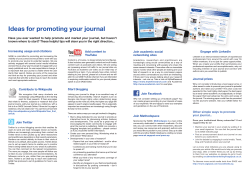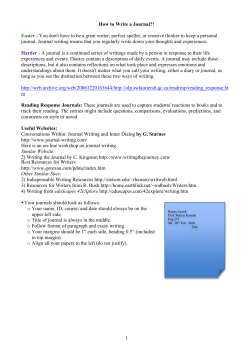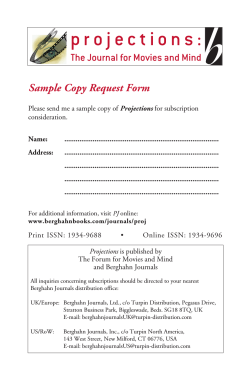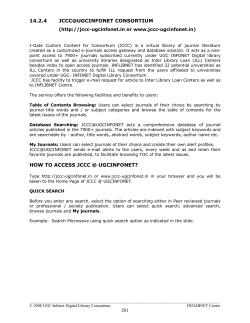
Introducing the next generation of —now complete SAGE Journals Online (SJO)
Introducing the next generation of SAGE Journals Online (SJO)—now complete Los Angeles | London | New Delhi Singapore | Washington DC Why SAGE migrated to the next generation of SJO? ● After much consultation with end-users, librarians and society partners, we undertook a major upgrade of the SJO platform to a new environment supported by HighWire’s “2.0” technology (nicknamed “H20”) ● Core changes are infrastructural and “behind the scenes” – designed to cooperate with emerging web services and technologies, as well as comply with proven industry standards for content delivery ● The enhanced platform ensures that our journal sites are a valuable service to users: a place for people to do research, interact with information, ideas, and each other New features and functionality ● Redesigned main portal page - provides targeted user options for improved navigation ● Agile, robust content architecture, hosted in industrystandard, NLM metadata format ● Enhanced journal and society branding – home page designs will include greater prominence of journal titles and association logos, names and links to society sites. ● Expanded discipline search and browse – new search and browse capabilities across 50+ disciplines ● Abstract preview – mouse-over entries from tables of contents and search results provide pop-up previews of abstracts, without you having to leave the page New features and functionality (continued) ● Popular articles list – most-viewed and most-cited article lists readily available from all pages within a journal site ● Keyword pivot searches – article keywords are now hyperlinked to perform quick searches of that term within all content in that journal ● Feature hideaway – author affiliations, related links, and other functions can be expanded or hidden from view with your preferences retained throughout your session ● Tag-along navigation – content features follow alongside as users scroll down the article page ● Pop-up references – full citations pop up when you hover over reference numbers within the text of an article (for fulltext journals) Features that are not changing ● Basic personalization settings – alerts, usernames/passwords, and subscription data has been carried over ● Toll-free inter-journal linking feature ● All access controls and account management ● Saved Citations and Saved Searches feature ● Usage reporting ● All administrative functions End-user experience ● Flexible three-column design makes features accessible without drawing attention away from the substantive article content ● Major goal of new design is to keep readers in context as they conduct research Librarian experience ● SJO portal home page now features enhanced navigation for librarians to many commonly used pages for account management ● Basic functionality around these administrative features, including access to usage statistics, remains the same ● Core SJO access control system and subscription database remain unchanged OpenURL linking and Proxy servers ● All current URLs for SAGE journal sites have successfully been mapped over ● All other HighWire site migrations to date have proved to successfully and smoothly transition all URL resolution with library systems and services Training materials ● The SAGE Journals Online User Guide is updated and available online. The User Guide shows how to utilize the new features of the platform, including the new advanced search and browse by discipline options, and how to register for a My Tools account for customizable TOC alerts and Saved Searches SAGE Full-Text Collections on SJO ● Specific functionality for the SAGE Full-Text Collections on SJO has ended ● Current Collections subscribers will continue to maintain access to the journal content of the Collections on SJO; however users will no longer see a dedicated screen with search options across the individual Collections ● The expanded discipline functionality across the new advanced search feature has replaced the Collectionspecific search screen Customer technical support ● For technical support for the next generation of SAGE Journals Online, including assistance with SAGE Full Text Collections access, contact: • Customers in North America and South and Central America: onlinesupportus@sagepub.com • Customers in Europe, the Middle East, Africa, Asia, and Australasia: onlinesupport@sagepub.co.uk Comparison of features Feature SAGE Journals Online Next Generation of SAGE Journals Online Browse ● Browse by journal title ● Browse articles by discipline using TopicMap ● Browse by Full Text Collection (only for Collections subscribers) ● Browse by journal title ● Browse journals by expanded discipline functionality across 50+ categories (replacing SAGE Full Text Collections) Search/Advanced Search ● Boolean operators ● Cannot search by discipline ● Search by Full Text Collection (only for Collections subscribers) ● Boolean operators ● Advanced search within expanded discipline functionality across 50+ categories (same categories as available for content alerts) Email Alerts ● Users can choose alerts for journal announcements or new articles and issues (eTOCs) via browse of individual journal titles. ● Users can choose alerts for journal announcements or new articles and issues (eTOCs) via browse of individual journal titles or their related subject categories, expanded to more than 50 categories. Comparison of features Feature SAGE Journals Online Next Generation of SAGE Journals Online Reference linking ● Open URL 1.0 linking to articles ● Linking to CrossRef, PubMed®, Google Scholar and Web of Science ● Toll-free inter-journal linking to full text of cited articles within the SJO and HighWire Press platforms ● Open URL 1.0 linking to articles ● Linking to CrossRef, PubMed®, Google Scholar and Web of Science ● Toll-free inter-journal linking to full text of cited articles within the SJO and HighWire Press platforms Portal page ● Simple introductory page with Quick Search box ● Redesigned portal page with focus on diverse types of visitors, expanded navigational options and more prominent search placement Abstracts ● Access to table of contents, abstracts and full text articles hosted on separate pages ● Abstract preview allows users to mouse-over entries on the table of contents and search results pages to view instant pop-up abstracts, without leaving the page. Note: This pop-up functionality will increase abstract counts on usage reports. ● Tables of contents, abstracts and the full text of articles will continue to be accessible via their own pages within journal sites. Comparison of features Feature SAGE Journals Online Next Generation of SAGE Journals Online Navigation ● Standard navigation maintains static page as user scrolls ● Tag-along navigation allows various content feature options to follow alongside users as they scroll through the article page Related articles ● Offers links to “similar articles” in the content box next to the article or abstract ● Extended list of options will be available for viewing “more like this” content ● Keyword pivot searches – article keywords are now hyperlinked to perform quick searches of that term within all content in that journal Customization of features ● Institutional branding available ● Institutional branding available ● Feature hideaway – Author affiliations, related links, and other optional article functions can be expanded or hidden. Your article enhancement preferences are remembered throughout your session. Comparison of features Feature SAGE Journals Online Next Generation of SAGE Journals Online Usage reporting ● COUNTER3-compliant usage reports can be downloaded by the account administrator ● COUNTER3-compliant usage reports can be downloaded by the account administrator Content architecture ● Limited proprietary XML-based sites without compliance to industry standards or options for agile extensibility ● Agile and robust content architecture, hosted in industrystandard NLM metadata format
© Copyright 2025















